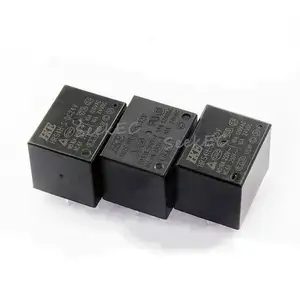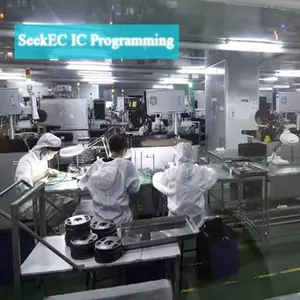Types Of 12-Volt Relays
Automotive relay
- In automatic electrical systems, an automotive relay acts as a switch. It controls high-current circuits by using a small current to operate the relay. This enables low-current circuits to control the operation of high-current devices like headlights, fans, and pumps.
- The usage of relays in modern vehicles is significant. They allow for the control of many systems from a single point, thus enhancing the efficiency of the electrical system. Their ability to handle heavy loads makes them essential for maintaining safe and reliable operation in automotive power systems.
General purpose relay
- General-purpose relays are versatile electro-mechanical switches. They are applied in various applications to control moderate power circuits. Due to the ability to open and close multiple contacts, these relays are ideal for switching applications in industrial and commercial settings.
- Their adaptability allows them to be deployed in diverse settings. These include automation systems, HVAC units, and lighting control. This makes them a favourite among engineers. General-purpose relays come with high reliability. This is essential for controlling and protecting electrical equipment.
Solid State Relay
- A Solid State Relay (SSR) is an electrical device. It switches power using a low power signal without moving parts. This robust design meaning no mechanical wear allows for longer life under various conditions.
- SSRs provide faster switching and high resistance to vibration and shock. These features make them suitable for critical applications. Because of their ability to switch high loads with extreme precision, they find application in temperature control systems, industrial automation, and electric motor drives. Their ability to withstand harsh environments and maintain accurate control makes them indispensable in many industries.
Relay outlet
- An outlet is a specialized device. It integrates relays into power sockets to control the flow of electrical energy. Users can switch off or on connected devices through the control mechanism within the relay.
- This effectively manages power usage. It adds a layer of convenience and energy efficiency. Relay outlets are especially useful in situations where remote access to power is needed. These include lighting systems, electronic devices, and industrial equipment. Moreover, they help prevent overloads and improve safety.
Specifics Of 12-Volt Relay
Technical Specifications
- Coil Voltage and Current: This is the voltage applied to the relay coil to energize it. The 12V relays have a current range from 0.1 to 0.2 A, depending on the type.
- Contact Rating: This refers to the maximum load or current that the relay can handle through its contacts. For automotive relays, this is often 30 A or more.
- Switching Capacity: This is the total power that can be handled by the relay. There is AC and DC voltage for a 12V relay. It is typically up to 250 V AC and 30 V DC.
- Contact Configuration: 12V relays come in diverse configurations. These include single pole double throw (SPDT) or four pole four throw (FPFT).
- Material and Dimensions: Most relays are made of plastic housings and metal contacts. The size may vary with the model but is typically around 8 cm in length and 6 cm in width.
Installation Instructions
- Remove Power: The applied power to the system must first be disconnected. This prevents electrical shock and injury.
- Mounting the Relay: Find a suitable location to house the relay. Ensure that the area is well ventilated without any obstruction.
- Connecting the Coil Terminals: Connect the positive terminal of the coil to the 12V power source. Connect the negative terminal to the control signal or ground.
- Wiring the Load Terminals: The common terminal of the relay wire to one side of the load. Then connect the other side to the power source.
- Secure the Relay: Ensure that the relay is safely and securely mounted. Double-check all connections.
- Reapply Power: The power must then be reapplied to the system for the relay to function as expected.
Maintenance And Repair
- The first method of maintenance and repairs starts with regular inspections. Looking for problems like physical damage, corrosion, or loose connections is important. It is also important to check for excessive heat or wear around the relay area.
- Monitoring the voltage and current levels ensures they are within the specified range to prevent overloads of a 12vdc relay. One must also clean dust and debris off the area. This will improve airflow and reduce the risk of overheating.
- On the mechanical side, users should consider periodically checking the functionality by manually activating the relay. This will ensure that it is switching properly. If there are any signs of malfunction or frequent failure, replacing the relay is important.
- Using OEM parts during replacement is vital for relay maintenance. OEM parts help maintain the integrity and reliability of the 12v relay. Building a schedule around maintenance based on the application is important. This will minimize downtime.
- One must also consider training staff on proper handling and installation procedures. This avoids unnecessary damage.
How To Choose A 12-Volt Relay
- Start by considering the relay's application. Understanding whether it will be used in an automotive system, home applications, or heavy duty industries will narrow down the choices.
- The 12V relay's coil current and voltage must match the circuit specifications. A general rule states that it should exceed the system's maximum current for relays used in high-load applications.
- The relay's contact rating has to be high. This means it should be higher than the load's operating current. It will help eliminate overloads and ensure long-lasting performance.
- Also consider the relay's form factor and configuration. These are important in tightly spaced environments where only a small relay can fit. A SPDT relay is applicable in simple switching. FPFT relays are ideal for complex, multi-channel applications.
- Electromechanical relays are favoured for their robustness in reliable performance. Solid-state relays provide faster switching. They come with lower maintenance requirements. Taking all these factors into considerations will lead to a perfect 12V relay.
Q&A
Q1. Which applications are common for the 12V relay?
A1. 12 Volt relays operate in automotive, industrial, marine, and HVAC fields. An example is the automotive 12V relay. It is widely used to control high-current circuits for headlights, motors, and fans. Factories employ general-purpose relays for equipment automation or circuit protection. The relays are also prevalent in marine applications.
They manage power to navigation lights and bilge pumps. Their resistance to moisture is helpful. HVAC systems utilize relays to control compressors and fans. This ensures effective temperature control. Overall, their versatility, precise control, and ability to handle heavy electrical loads make them ideal for diverse applications.
Q2. Are the 12V relays essential in home appliances?
A2. Yes, a 12V relay is vital in home appliances. They are particularly useful in devices requiring low-power signals to control high-power loads. For instance, in HVAC systems, relays switch compressors, fans, or heating elements. This allows the thermostat to control the appliance from a distance.
They are also used in automation systems. Here, they control lighting, security systems, and power outlets. Microcontrollers and other low-voltage circuits directly trigger the relays. They provide a buffer between these low-power control systems and high-power loads. In summary, they increase energy efficiency and system reliability in home appliances.
Q3. Are there the consequences of using lower quality 12V relays?
A3. Yes, there are multiple consequences of using low-quality 12V relays. These include failures, reduced lifespan, erratic behaviour. Quality relays come with reliable performance. They ensure that the system operates smoothly without frequent dropouts or malfunctions. Poor-quality relays wear out faster due to lower tolerance against heat, vibrations, and high currents.
This leads to component replacement. It negatively impacts system uptime. Substandard relays influence control signals. This causes delayed switching or failure to switch, which can lead to operational inefficiencies in systems like automotive, industrial, and marine applications. They also have material with subpar electrical contact. This comes with an increase in resistance over time. It leads to unstable signals and inconsistent performance in the 12-volt relay.
Q4. How will one easily identify a broken relay?
A4.A broken 12V relay can easily be identified in several ways. Firstly, by listening for clicking sounds when energizing it, there should be a solid click. If there are no clicks, the relay might be faulty. Secondly, check for heating. A relay that overheats or remains extremely cold after being powered may be defective. One should also visually inspect for burns, corrosion, or damages in the housing.
These indicate a failure. If the relay is accessible, a multimeter can test it for continuity between the coil and contacts. Lack of continuity means the relay is broken. The relays are also tested using an external 12V power supply. Applying voltage to the coil should activate the relay. No switching action means failure. Lastly, replacing with a known good relay can easily confirm the problem.







































































































































































































